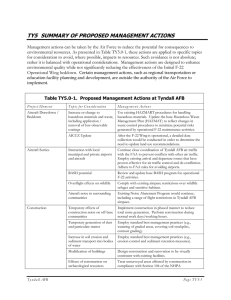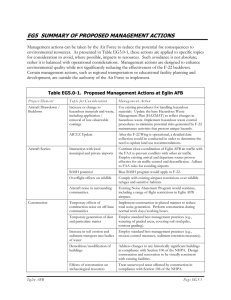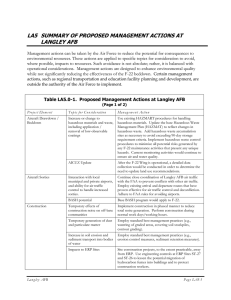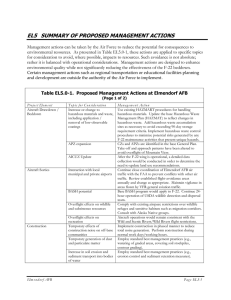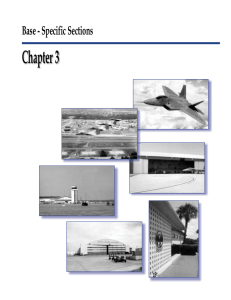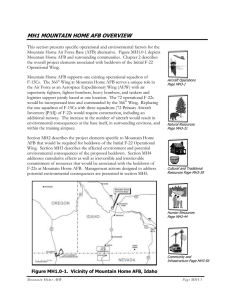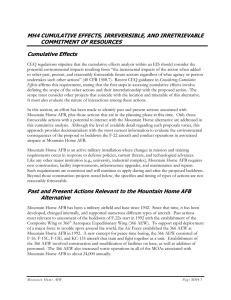5.0 CUMULATIVE EFFECTS AND IRREVERSIBLE
advertisement
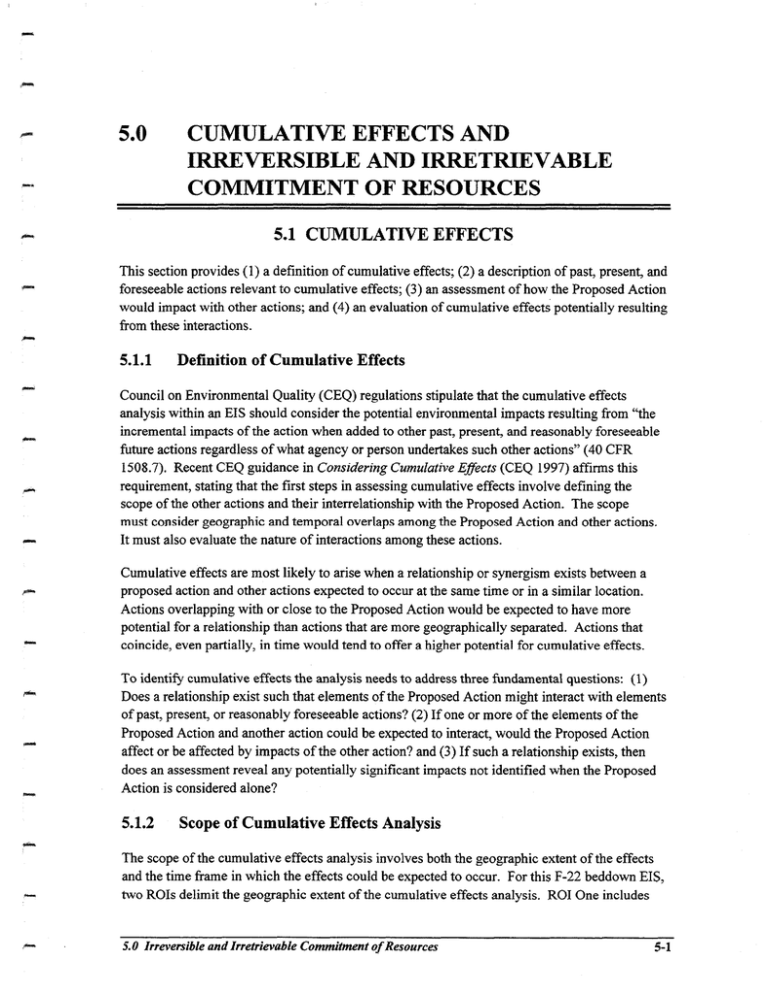
5.0 CUMULATIVE IRREVERSIBLE COMMITMENT EFFECTS AND AND IRRETRIEVABLE OF RESOURCES 5.1 CUMULATIVE EFFECTS This section provides (1) a definition of cumulative effects; (2) a description of past, present, and foreseeable actions relevant to cumulative effects; (3) an assessmentof how the Proposed Action would impact with other actions; and (4) an evaluation of cumulative effects potentially resulting from these interactions. 5.1.1 Definition of Cumulative Effects Council on Environmental Quality (CEQ) regulations stipulate that the cumulative effects analysis within an EIS should consider the potential environmental impacts resulting from “the incremental impacts of the action when added to other past, present, and reasonably foreseeable future actions regardless of what agency or person undertakes such other actions” (40 CFR 1508.7). Recent CEQ guidance in Considering CumuZative Effects (CEQ 1997) affirms this requirement, stating that the first steps in assessing cumulative effects involve defining the scope of the other actions and their interrelationship with the Proposed Action. The scope must consider geographic and temporal overlaps among the Proposed Action and other actions. It must also evaluate the nature of interactions among these actions. Cumulative effects are most likely to arise when a relationship or synergism exists between a proposed action and other actions expected to occur at the same time or in a similar location. Actions overlapping with or close to the Proposed Action would be expected to have more potential for a relationship than actions that are more geographically separated. Actions that coincide, even partially, in time would tend to offer a higher potential for cumulative effects. To identify cumulative effects the analysis needs to address three fundamental questions: (1) Does a relationship exist such that elements of the Proposed Action might interact with elements of past, present, or reasonably foreseeable actions? (2) If one or more of the elements of the Proposed Action and another action could be expected to interact, would the Proposed Action affect or be affected by impacts of the other action? and (3) If such a relationship exists, then does an assessmentreveal any potentially significant impacts not identified when the Proposed Action is considered alone? 5.1.2 Scope of Cumulative Effects Analysis The scope of the cumulative effects analysis involves both the geographic extent of the effects and the time frame in which the effects could be expected to occur. For this F-22 beddown EIS, two ROIs delimit the geographic extent of the cumulative effects analysis. ROI One includes 5.0 Irreversible and Irretrievable Commitment of Resources 5-l F-22 Force Development Evaluation and Weapons School Beddown, Nellis AFB Nellis AFB and its vicinity, including Las Vegas and its associated airspace. ROI Two defines the horizontal boundaries of the NRC and the vertical boundaries of its overlying airspace. Examination of other actions not occurring within or adjacent to one or both of these ROIs reveals that they lack the necessary interactions to result in cumulative effects. The time frame for cumulative effects centers around the timing of the Proposed Action. For the beddown itself, the time frame extends from 2000, when construction would begin, through 2008, when the last F-22s would arrive at Nellis AFB. The effects of implementing the FDE program and WS would continue beyond 2008 because new aircraft commonly remain in the inventory for 25 years or more. Actions occurring beyond the end of the beddown, other than the beddown and its operations or the continued use of Nellis AFB and the NRC, are not reasonably foreseeable and cannot be considered under cumulative effects. Past actions within the two ROIs relate predominantly to activities on and use of Nellis AFB and the NRC. Under the No-Action Alternative, the current environmental conditions of these two areas underwent analysis in this EIS. Since those conditions represent the result of long-term use occurring at Nellis AFB and in the NRC, analysis of the No-Action Alternative has considered those past and present effects engendered by the operation and use of the base and range complex. The Legislative EIS for the withdrawal renewal also addresses the effects of the use of NAFR. The FDE program and WS EIS also has assessedthe interactions, or synergistic effects, of individual elements of the proposed F-22 beddown under each resource (sections 4.1 through 4.12). For example, analyses considered the combined effects of construction, increased vehicle use, and aircraft operations on the air quality within ROI One (section 4.3). Another factor influencing the scope of cumulative effects analysis involves identification and consideration of other actions. Beyond determining that the geographic scope and time frame for the actions interrelate with the Proposed Action, the analysis employs the measure of “reasonably foreseeable” to include or exclude other actions. For the purposes of this analysis, public documents prepared by federal, state, and local government agencies form the primary sources of information regarding reasonably foreseeable actions. Scoping also can provide insight into such actions, but no comment received at scoping for this EIS identified other such actions. Documents used to define other actions included notices of intent for EISs and Environmental Assessments,management plans, land-use plans, other NEPA studies, and economic and demographic projections. 5.1.3 Cumulative Effects of Reasonably Foreseeable Actions Actions potentially relating to the cumulative effects for the proposed F-22 beddown could include those of the Department of Defense, Department of Energy, Department of the Interior, and local counties. The following outlines these actions and assessestheir relationship to the proposed beddown. The amount of detail available about the actions varies, so this assessment 5-2 5.0 Irreversible and Irretrievable Commitment of Resources F-22 Force Development Evaluation and Weapons School Beddown, Nellis AFB can only present the degree of specificity supported by available information on both the actions and their potential effects. DEPARTMENT OF DEFENSE ACTIONS Three DOD actions, one ongoing and two proposed, overlap with the proposed F-22 beddown in terms of location and timing. The ongoing action consists of use of existing MTRs that partially lie within NRC airspace. The Proposed Actions include conducting Initial OT&E for the F-22 at Edwards AFB, California, and renewing the NAFR land withdrawal under Public Law 99-606. EXISTZNGMARS: DOD has established several different MTRs within or adjacent to the NRC airspace that may or may not be flown in conjunction with NRC missions. An MTR consists of airspace corridors created for military flight training at airspeeds in excessof 250 knots and below 10,000 feet MSL. Designed to support low-level training requirements while minimizing disturbances to people and property, MTRs commonly avoid airports, towns, wildlife refuges, and other noise-sensitive locales. MTRs that transit or enter NRC airspace include segments that allow flight as low as 100 feet AGL, but normally flights occur between 500 and 1,000 feet AGL. Two types of MTRs exist: instrument routes (IRS) and visual routes (VRs). Because portions of these MTRs overlap with NRC airspace in which the F-22s would fly, the potential for cumulative effects exists. It is expected that use of these MTRs would continue into the foreseeable future, coinciding with the time frame in which the F-22 would operate in the NRC. However, use of the MTRs constitutes an existing activity. The additive effects of current MTR use and proposed F-22 sortie-operations are assessedunder the analysis of the Proposed Action. Since the F-22 beddown does not propose to add sortie-operations on specific MTRs, the beddown would not influence the type or quantity of use of the MTRs, nor would MTR use affect the beddown. F-~~INITIALOT&EATEDWARLLSAFB, CALIFORNIA: Edwards AFBisaprimaryweapons system and aircraft testing facility for the Air Force. The Air Force proposes to conduct Initial OT&E for the F-22 at Edwards AFB between 2002 and 2003. An EA evaluating the proposed Initial OT&E activities, in preparation now, and is expected to be published in mid 1999. Results of the Initial OT&E program determines whether the F-22 meets initial operational capability criteria before the program proceeds to full-rate production. To fulfill the needs of these programs, the Air Force would conduct flight operations in airspace and over ranges that provide realistic challenges. In preparation for and as part of the Initial OT&E program, the Air Force proposes to fly approximately 500 sorties within the NRC airspace from spring 2002 through spring 2003. Of these sorties, about half would focus on pilot training, whereas the remainder would represent flight tests. All flight operations would adhere to existing airspace restrictions applicable to the NRC, but the airspace would be used to its full extent. Each of the flight-test sorties would likely involve a supersonic event; some may occur at 3,000 feet AGL within R-4807A airspace, whereas the remainder would be at altitudes of 5,000 feet AGL or higher. 5.0 Irreversible and Irretrievable Commitment of Resources 53 F-22 Force Development Evaluation and Weapons SchooC Beddown, Nellis AFB To support the test efforts, chase aircraft (e.g., F- 16s), refueling tankers, and Airborne Warning and Control System aircraft would fly in the NRC. These aircraft would generate a total of about 2,300 additional sorties within the NRC. Although not specified in the proposal, sortieoperations in the NRC over the approximate 1S-month period of the action would total about 16,500 for all aircraft, with the F-22s contributing approximately 5,300 sortie-operations. All of these sortie-operations are included within the 200,000 to 300,000 range of sortie-operations within the NRC. The cumulative effects of the total sortie-operations are encompassed within analyses in Chapter 4. NAFR LAND WITHDRAWALRENEWAL:Under Public Law 99-606, the Secretary of the Military Service is required to determine the need for continued exclusive military use of NAFR and prepare appropriate environmental analyses. This effort is currently underway in the form of a Final Legislative EIS, Renewal of the Nellis Air Force Range Land Withdrawal, published in March 1999. The purpose of the land withdrawal renewal for NAFR is to continue to provide a safe and secure location that permits testing of high performance weapons systems and tactics and supports realistic training for military personnel to meet nationally directed missions. Continuance of exclusive DOD use of NAFR would support the full spectrum of training for military operations. A decision to not renew the land withdrawal for NAFR would likely eliminate the air-to-ground training ranges, instrumentation, and other facilities that make it important and unique. Such a decision would not eliminate the overlying airspace, but without the ground-based facilities, the spectrum of aircraft operations conducted in the airspace would diminish significantly. The land would revert to the BLM. The Air Force’s decision to beddown the F-22 and congressional decisions regarding continuing the withdrawal for NAFR represent independent actions resulting in separate decisions. The decision to beddown the F-22s at Nellis AFB for the FDE program and WS would not dictate a decision to renew the land withdrawal. As presented in the range renewal Legislative EIS and this EIS, the NAFR supports numerous important functions and activities for the military including major exercises and FDE program and WS for many aircraft. The activities proposed for the F-22 at NAFR would not increase total use of the range or NRC. Flight activities at NAFR for the F-22 would represent between 9 and 13 percent of the total use of the range. Ordnance use by the F-22s would comprise less than 1 percent of total weapons delivery activities. Therefore, there would be no cumulative impacts. DEPARTMENT OF ENERGY ACTIONS The DOE recently completed an evaluation of potential site-wide impacts of future development of the Nevada Test Site (NTS) and other associated sites in Nevada. This evaluation included analysis of four development alternatives (current operations, discontinued operations, expanded operations, alternative uses) with respect to its five major programs (defense, waste management, environmental restoration, non-defense research and development, and work for others). The framework for an NTS resource management plan was also presented in the sitewide EIS. The Record of Decision identified expanded use of the NTS pending other DOE decisions. If fully implemented, this decision would result in a multipurpose, multi-program use 5-4 5.0 Irreversible and Irretrievable Commitment of Resources F-22 Force Development Evaluation and Weapons School Beddown, Nellis AFB F of lands withdrawn by DOE, although much of the NTS would remain in exclusive use. DOE will pursue diversification of interagency, private industry, and public education use while meeting the mission requirements of the NTS and other Nevada sites. Site characterization studies at the Yucca Mountain in Nye County are ongoing and designed to determine whether the site is suitable for the storage and isolation of high-level radioactive materials and spent nuclear fuel. DOE anticipates making a recommendation in 2001 to the President on the suitability of the Yucca Mountain site for this purpose. If suitable, following Nuclear Regulatory Commission review and approval, construction could be completed and operations could commence by 20 10. pr r” *n* CI The DOE proposes that low-level nuclear waste (LLW) be transported from a number of DOE/NV-approved LLW generators to a disposal site located on the NTS utilizing rail and truck transportation modes and an intermodal transfer facility. The use of rail and truck modes and alternative routes could reduce radiological risk, improve safety, and reduce costs for transporting LLW from generator sites to the NTS. LLW would be shipped via rail to an inter-modal facility near the NTS where the cargo would be transferred to trucks for delivery to waste disposal sites at the NTS. The proposed action and alternatives address routes that would avoid the Las Vegas Valley and Hoover Dam. Locations for the proposed intermodal facility are (1) an existing intermodal facility in Barstow, California operated by the Burlington Northern Santa Fe Railroad, (2) a facility proposed by the City of Caliente, Nevada (at either of two potential locations), and (3) an existing intermodal facility at the rail terminal of the Yermo Annex operated by the U.S. Army in Yermo, California. Although these actions occur on lands underlying NRC airspace, they are independent of the proposed F-22 beddown and use of that airspace. Decisions concerning the NTS and Yucca Mountain would not influence decisions regarding the F-22. Furthermore, use of the overlying airspace by the F-22 would not contribute to the effects of the activities at the NTS or Yucca Mountain. For these reasons, there would be no cumulative impacts. DEPARTMENT OF INTERIOR ACTIONS BUREAUOFLAND A~ANAGEMENT: The Stateline Resource Area (now part of the Las Vegas District) comprises approximately 3.7 million acres of public land in Clark and Nye counties. The resource area is bordered by the Caliente Resource Area, USFWS Desert National Wildlife Range (DNWR), NAFR, and NTS. In the Stateline Resource Management Plan (BLM 1992b), the BLM’s preferred alternative, Alternative D, provided for multiple-use of public lands, permits maximum flexibility in the disposal of lands, and protects the desert tortoise. The Tonopah Resource Area (now divided between the Las Vegas and Ely districts) includes approximately 6.1 million acres of land in Nye and Esmeralda counties. The Tonopah Resource Management Plan (BLM 1994) and EIS addressed issues including wild horse and burro 5.0 Irreversible and Irretrievable Commitment of Resources 5-5 F-22 Force Development Evaluation and Weapons School Beddown, Nellis AFB management, special management areas, off-highway vehicle use, management of released wilderness study areas, utility corridor routing, and locatable and fluid minerals. The BLM’s decisions in these resource areas are not related to the F-22 beddown. The F-22 is a continuation of aircraft activity within the NRC and will not change the nature of airspace use. Therefore, there are no cumulative impacts. U.S. FISHAND WILDLIFESERVICE: The USFWS withdrawal of the DNWR continues the limited accessand single use of these lands and is not expected to increase the area of disturbance. Management of the DNWR resources, including occasional species introductions and restricted hunting, would continue. The decision to renew the withdrawal of the DNWR, as well as its effects on the environment, are unrelated to the proposed F-22 beddown. No aspect of the renewal would alter or add to the types of operations conducted in the airspace overlying the DNWR, even with the addition of the F-22s. As indicated in section 2.2 and throughout Chapter 4 of this EIS, beddown of the F-22s at Nellis AFB and their use of the NRC would not change the amount or nature of overflights of the DNWR. For these reasons, no interaction exists between the two actions and the DNWR renewal is not included in the analysis of cumulative effects. LOCALACTIONS While not involving specific actions, planning and anticipated growth in local cities as well as Clark, Nye, and Lincoln counties in Nevada represent factors worthy of consideration for cumulative effects when combined with the proposed F-22 beddown. Nellis AFB, Las Vegas, and a portion of the NRC lie within Clark County, whereas Nye and Lincoln counties encompass the majority of the NRC. As discussed in Section 3.11, census data and other information indicate that Clark County exhibited the greatest growth in population within the U.S. over the last 15 years. From 1980 through 1996, population increased 112 percent; estimates for 1996 place the county population at 1.2 million people. This amount exceeds that anticipated in the Regional Transportation Plan for Clark Cou@ (Regional Transportation Commission 1994), which anticipated that Clark County’s population would increase to approximately 1.2 to 1.4 million people by 2005. Key economic and development forces that influence future private activities and the character of Nye County and its communities include federal activities at the NTS and NAFR, mining and tourist activity, migration and commuting patterns, and the local service sector activity. Population projections for Nye County (Nye County Board of Commissioners 1993) indicate an average annual growth of 4.6 percent from 1990 to 2010. However, economic growth in the Las Vegas Valley and the availability of low cost land and housing in the Pahrump area of Nye County would support this population increase. This area is expected to grow at approximately 7.6 percent per year during the same period. Nye County anticipates this growth will convert approximately 2,000 acres of undeveloped land to urban uses by 2005. Based on demographic 5-6 5.0 Irreversible and Irretrievable Commitment of Resources c F-22 Force Development Evaluation and Weapons School Beddown, Nellis AFB projections prepared as part of this document, the population of Lincoln County is forecast to increase from 3,727 in 1996 to 4,552 in 2026. For socioeconomics, the original ROI for the F-22 beddown included Clark, Nye, and Lincoln counties. Analysis in section 4.11, Socioeconomics, however, establishes that population growth and its accompanying impacts resulting from the F-22 beddown would occur only within Clark County and the Las Vegas area. Thus, the lack of a geographic overlap of the growth in Nye and Lincoln counties and the effects of the F-22 beddown confirm that no interaction exists and there are no cumulative impacts. 5.2 IRREVERSIBLE COMMITMENTS AND IRRETRIEVABLE OF RESOURCES NEPA requires that environmental analysis include identification of “. . .any irreversible and irretrievable commitments of resources which would be involved in the Proposed Action should it be implemented.” Irreversible and irretrievable resource commitments are related to the use of nonrenewable resource and the effects that the uses of these resources would have on future generations. Irreversible effects primarily result from the use or destruction of a specific resource (e.g., energy and minerals) that cannot be replaced within a reasonable time frame. Irretrievable resource commitments involve the loss in value of an affected resource that cannot be restored as a result of the action (e.g., extinction of a threatened or endangered species or the disturbance of a cultural site). For the Proposed Action, most resource commitments are neither irreversible nor irretrievable. Most impacts are short term and temporary or longer lasting but negligible. Those limited resources that may involve a possible irreversible or irretrievable commitment under the Proposed Action are discussed below. Facilities construction and maintenance for F-22 support and increased personnel would require consumption of limited quantities of aggregate, steel, concrete, petroleum, oil, and lubricants. Construction would occur on previously disturbed areas or locations lacking native habitat, so no irreversible loss of habitat and wildlife would result. Similarly, construction on base would avoid significant cultural resources. While construction of new facilities would incur some soil disturbance and loss, use of best management practices would localize and minimize soil loss. The proposed F-22 beddown would require fuels used by aircraft and surface vehicles. The 4,500 additional sorties from Nellis AFB would use fuel use for as long as the FDE program and WS continued. Surface vehicles supporting F-22 maintenance and operations would also use fuel, oil, and lubricants. Personal vehicle use by the additional staff proposed to support the F-22 beddown would consume fuel, oil, and lubricants. The amount of these materials used would not likely exceed that currently used by these same individuals and their families. The Proposed Action would not increase consumption of these resources. 5.0 Irreversible and Irretrievable Commitment of Resources 5-7 F-22 Force Development Evaluation and Weapons School Beddown, Nellis AFB Use of ordnance would cause negligible ground disturbance, soil exposure, and erosion. Areas affected by use of F-22 ordnance consist of existing targets, so new disturbance would be unlikely. In addition, quantities of steel and other materials used in construction of munitions and targets would be committed under the Proposed Action. For the F-22, the amounts of these materials would be minimal, representing approximately 3 to 5 percent of the annual ordnance delivery activities at NAFR. The effects on targets would not be changed. 5.0 Irreversible and Irretrievable Commitment of Resources
